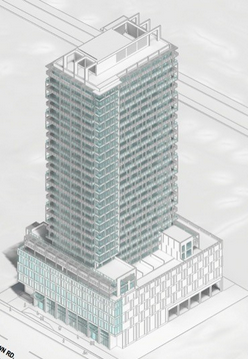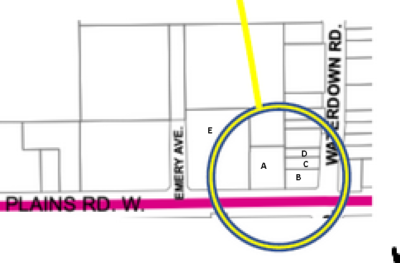 By Pepper Parr
By Pepper Parr
May 11, 2023
BURLINGTON, ON
Part 2 of a series
When we reviewed Councillor Galbraith’s audited campaign financials, available now on the City website, we noticed some anomalies and decided to look closer.
Focusing on the donors who donated $1000 or the maximum $1200, in more detail we asked:
Who are they?
Why did they donate this much money to a Burlington councillor in an election most voters ignored, where he was running against only one unknown opponent?
Did Galbraith need this amount of money to win his seat?
All Burlington Council incumbents won re-election easily, most with far less money needed.
Based on our research, including simple online searches, we note some information on several of the donors, which we believe to be both highly relevant and accurate. The $1200 and $1000 donors are:
Galbraith $1200 Donors:
Don Husack: Owner, Don Victoria Homes (Burlington resident)
Dr. Michael Shih: President, Emshih Developments (Burlington resident)
Jessica Dipronio: Executive Assistant, National Homes (Bolton resident)
Sara Defina: Executive Assistant, National Homes (Maple resident)
Jenne Wilches (Brampton resident)
Gunther Bluesz: Lead Designer & Project Manager, Vrancor Group (Hamilton resident)
Arun Anand: Manager of Construction Management Plan, Infinity Development (lists a Waterdown Road address, which doesn’t seem to exist)
Adam Peaker, (Burlington, Ward 1 resident)
Ken Szekely, (Burlington business address)
Galbraith $1000 Donors:
Jeffrey Paikin: President, New Horizon Development Group (Burlington resident)
Vincent Molinaro: President, Molinaro Development Group (Burlington business address)
Bruce MacDonald (Oakville resident)
Meetali Acharya (Burlington, Ward 1 resident)
Richard King (Burlington, Ward 6 resident)
Nigel Morgan (Burlington, Ward 4 resident)
Marion Cournoyer (Smithville resident)
Kathleen Sembrano (Burlington, Ward 4 resident)
The number of donations to Galbraith from those tied to the development industry are (as set out above) similar to the donations given to Councillor Sharman, a councillor in his 13th year on Burlington council, and one with a history of receiving developer donations.

National Homes development on Brant Street south of Havendale.
Mayor Meed Ward has (at least since the 2018 election) taken the position that she would not accept donations from any developer. Her Deputy Mayor of Business Development and Red Tape Reduction does not appear to follow this practice.
Galbraith was the subject of an Integrity Commissioner complaint that claimed he had a conflict of interest because he owned businesses and properties in Ward 1 and should recuse himself when development proposals within the Major Transit Service Area (MTSA) were debated at council. The complaint was found by the City of Burlington’s Integrity Commissioner to be without merit.

Ward 1 residents argued during the election that should Galbraith be re-elected, they would effectively be without representation at Council.
A group of Ward 1 residents argued during the election that should Galbraith be re-elected, they would effectively be without representation at Council because of his perceived conflicts of interest.
So, what might all this mean? Well, ultimately it all depends on your perspective, your politics and how you view elections and the role of the public office holder.
Elections can be expensive if the race is tight and the competition fierce. Some candidates are able to fund their campaigns out of their own pockets. However, when campaigns come in costing $25,000 or more that is difficult for most candidates to pay for – they look to their supporters.
None of the Burlington ward races, or that for Mayor, were close in 2022. Each incumbent won easily. So, why if there was no real need, did Galbraith continue to collect funds from supporters and does it impose an inherent conflict when sitting in judgment of their development applications?
The source of any campaign donation is a mirror of sorts; a reflection of a candidate’s values and the types of interests that he or she attracts. For example, small donations from a hundred or more people might suggest that the candidate has a lot in the way of grassroots support.
A smaller number of donations from specific groups or interests – it could be developers, the commercial sector, hospitality or particular parts of the political spectrum – suggest that these sectors identify with the candidate as someone who best represents their particular community.

A, D and C are properties owned by Galbraith. E is owned by Emshih Developments. B is a gas station at the corner of the intersection of Plains and Waterdown.

The yellow line that swoops through the graphic is the point where the Galbraith properties are located – on the west side of Waterdown. The have the same development designation as the property across the street.
Burlington has, in the recent past, had a concern with the amount of money the development community contributes and how, as a community of interest, it tends to target particular individuals as the beneficiaries of their generosity and support.

Ward 1 City Councillor Kelvin Galbraith first elected in 2018.
They give a candidate money because they believe that he or she is most willing to support their interests; that a particular individual running for public office understands how they operate and is aligned with what they want to achieve.
In this context, there is a reason why developers have given the Ward 1 candidate so much money. They see it as a business investment and a perfectly acceptable expression of their support for someone amenable to their interests.
Other voters, applying different perspectives, goals and objectives, might see it a little differently. The optics of the Deputy Mayor of Business Development and Red Tape Reduction – a business owner in his own right – being the recipient of a very focused donation effort by the development industry is unfortunate. It can lead to unfounded speculation and conclusions.
 Where large developers are concerned, the sheer scale and massive dollar amounts involved in their projects make them different from any other type of donor. They have much more to gain (or lose) by council support and approval or non-support of their projects.
Where large developers are concerned, the sheer scale and massive dollar amounts involved in their projects make them different from any other type of donor. They have much more to gain (or lose) by council support and approval or non-support of their projects.
The ethics of Council members receiving and accepting donations from developers who have or will have in the future development projects in their Ward or city is something which plays out province-wide every election, with many council candidates publicly declaring that they will or will not accept such donations.
In part three of this article, to be published early next week, we will look at what all this means; the thousands of dollars of donations made by developers to ensure that the Ward 1 incumbent was re-elected.
We’ll chart where the major developments are in Ward 1 and show just how strategic Galbraith’s major donors were in seeding and protecting their investments.
We’ll illustrate how a perfectly legal activity – the act of campaign funding – can have dimensions that are not particularly attractive for a public official and can, quite quickly, lead to conclusions that the official would find uncomfortable.


















